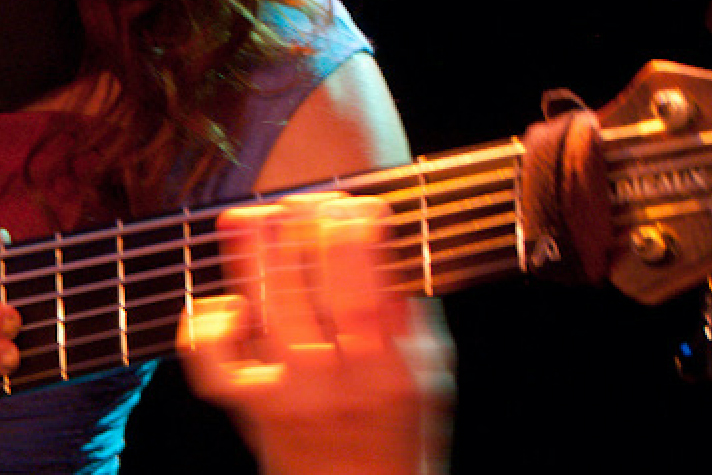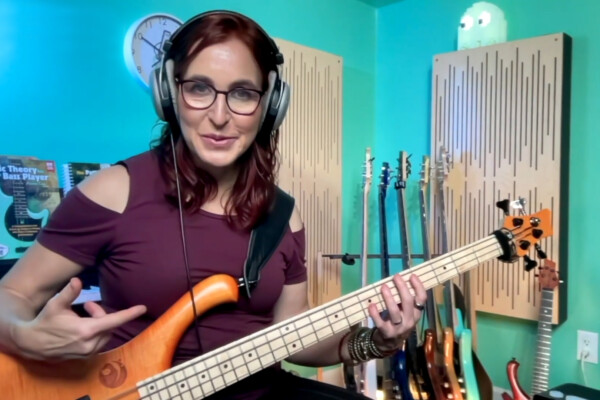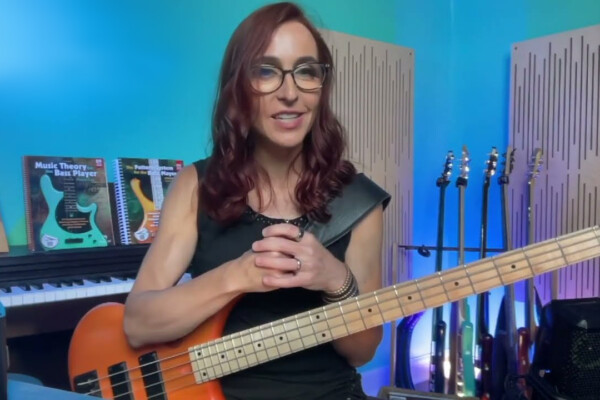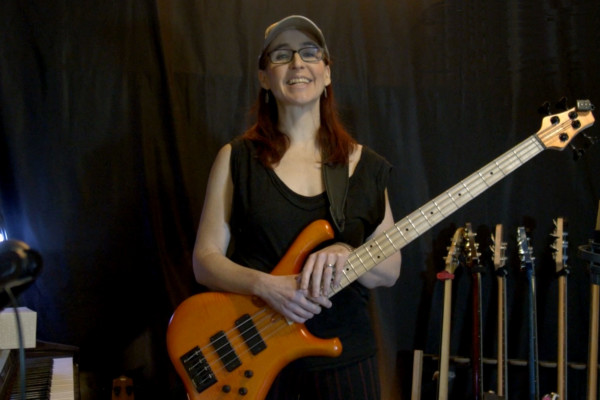Talking Technique: Close Your Eyes and “See” in New Ways

Let’s start with a simple exercise. I say, go ahead, get your bass and just do it – that way you get the full benefit from this article.
To start, let’s play a simple shift, such as C to D on the A string with the first finger on both notes (this is not the fingering I’d usually recommend, but this is an experiment, so go ahead).
- Look at your left hand performing the shift.
- Then, close your eyes and do it again, same fingering, same shift. Feel into your hand.
With your eyes closed, what did you observe? How was it different?
My experience is that the input from the kinesthetic and auditory senses seems to become much stronger with my eyes closed. How about you?
The Channels of Learning and Retrieving Information
Let me back up for a second and briefly define the channels of learning and retrieving information. I like to work with four (or five) main channels for bass playing:
- Visual: This can mean seeing fingers on the fretboard or a reading music from lead sheet. When the visual channel is predominant, we access information by visualizing the fretboard or shapes on the fretboard, or by seeing a chart or notes on staff with our physical eyes or within our mind’s eye
- Auditory: The ear guides us to the notes and provides feedback of how our playing sounds
- Kinesthetic: the feeling based channel. This refers to sensing our body and our body in relation to our environment. Kinesthetic means sensing the hand, shapes fingers make, feeling the vibrations of the bass. Also, our sense of rhythm is largely kinesthetic – a cool groove makes us want to move. When you practice a scale or arpeggio so that you have it “under your fingers,” then you have learned it kinesthetically.
- Conceptual: the thinking mind. Knowing note names, scale degrees, music theory or memorizing a tune by numbers and analysis makes up this learning and retrieving channel (more on that in a different article)
- Musical/consciousness of mind: how to best serve the song, enhance the lyrics/melody. This is where I place experiences we have gained from transcribing and assimilating through listening to our heroes. The so-called mirror neurons in the brain play an important role for this channel. This channel also concerns itself with the interaction between musicians, with deep listening, with being open to where the song takes you and the big mystery question: Where does the inspiration come from? (also a different lesson)
All of us have our predominant and favorite channels of learning and retrieving information. Most of the time, they all work together and enrich each other. In this context, I am mostly interested in the visual, kinesthetic and auditory senses and how temporarily eliminating one of them – the most predominant in our daily lives, namely visual – affects our experience.
Closing your eyes…
So what happens if we block out one of the channels? Typically, the other channels perk up. Energy will be diverted from the unused channel to the remaining ones. Closing your eyes will make your fingers feel that distance more intently and your ears sharper. Your hearing becomes the feedback mechanism telling you whether you moved the correct distance, you also feel if your finger landed on the correct spot (can you feel the fret? Are you on top or slightly beyond the fret?).
With your eyes closed, you have to rely on non-visual senses – primarily auditory and kinesthetic – the attention usually used for the visual sense is redirected to auditory and kinesthetic senses. That said, however, the internal visualization remains active: it helps to inform the kinesthetic and auditory senses by projecting an inner picture or movie of how the fingers and hand should move on the fret board.
This leads me to an interesting question arising from this little experiment: How exactly do we sense the distance the fingers or hand has to move when we are not looking?
I like to divide this up into the “big picture” (excuse the pun) or large scale aspects – the macro – and the details or smaller movements – the micro.
Calibrate your awareness, macro-style:
Notice
- the first fret (or nut);
- where the neck meets the bass body;
- where the fretboard ends;
- for the right hand: location of bridge and pickups and strings;
- the feeling of the bass body against your body
Calibrate your awareness, micro-style:
- Let the span of the hand become a meaningful measure.
- How far apart are your fingers?
- Feel the strings under your fingers – how close to the frets do you place your left hand fingers?
- With your right hand:
- sense the distance between the strings;
- sense the angle and force of your fingers plucking the strings
I encourage you to find and write out more examples in both categories.
Here is a great exercise for this calibration idea:
Part 1: Calibrating the one-finger-per-fret span
On the A string, finger C to Eb one-finger-per-fret style. Consciously affirm the span of your hand in that area of the bass. Four frets enclose a minor third or three half steps.
Part 2: Calibrating for jumps
Do the following with – and then without – looking: sense the location of the 4th finger on that Eb, then shift your first finger to that location. You can do the same with other fingers – practice these shifts back and forth.
Part 3: Calibrating for hand span plus one fret
We are still on the A string. With eyes closed, can you sense C to E, a major third, or four half steps, five frets total?
This is still relatively easy to sense as it is just the next fret over from the hand span shifts you practiced in Part 2. Practice by doing it often and feeling into your hand – and also into the arm. How much does the left under arm move? Keep the shoulder (and for the most part also the elbow) steady, like a pivot point.
Part 4: Once you hit the right notes most of the time, start expanding your range.
You’ll notice that the larger the jumps are, the more your macro-calibration comes into play. When sensing/thinking in distances of multiple handspans becomes impractical, the large-scale sense of where on the bass you land, like close to where the neck meets the body or other reference points you chose (I like the 12th fret), becomes a great help to movement accuracy.
You can come up with similar exercises for the right hand, shifting your plucking fingers between the strings without looking.
These exercises are quiet and introspective. Do not underestimate their power, however. It’s a great benefit to know your instrument with eyes closed – literally. It makes sense to really feel distances and landmarks without looking.
Purpose and Benefits
Am I advocating playing without ever looking at the fretboard? Absolutely not. But I am looking (ha!) to make a case to include practicing without looking in your regimen, at least for a short time each session.
One area where this type of practice gives you immediate pay-off is reading music: how useful is it to keep your eyes on the page rather than having to jump back and forth between the music and the neck? Or being able to observe the bandleader, fellow musicians or the audience for that matter? I think very.
But even beyond that, this approach trains you to trust what you feel and hear and strengthens a deeper sense of knowing. It affirms that your ears and body can guide you.
Whenever you slow down and practice with increased awareness, you increase your confidence with the instrument. When we play, countless complex movements happen at once – It becomes very hard to keep track of everything over multiple senses when playing fast. Slow everything down and give your mind time and space to expand your awareness. Tuning out the visual channel is a great way to do that because it trains you to sense your hands, arms, and your entire body, raising awareness of your movements and helping you play effortlessly. And your sense of hearing also receives a boost and chances are you’ll hear details in the sound that evaded you before.
Which, in the bigger scheme of things, makes us look (without, um, actually looking!) at what playing effortlessly means. To me, it has to do with using only the amount of force and only precisely the muscles needed, no extra tension so the music can flow. This is a very physical – kinesthetic – experience and since this exercise enhances your kinesthetic powers, it will help you achieve effortlessness.
And, when tuning out the visual channel, you may simply find it enhances the physical sensations from playing bass, such as:
- feeling the vibrations of the instrument
- sensing the sound through your body (bones!)
- getting the physical impact of bass more directly
In essence, it helps you feel the music. Isn’t that just so delicious?
Austrian-gone-Californian Ariane Cap is a bassist, educator, blogger and author. In her book Music Theory for the Bass Player and corresponding 20-week online course, she teaches music theory, bass technique, bass line creation and fretboard fitness in a systematic, practical and experiential way. She just released a brand new course on ear training for the bass player: Ear Confidence - 6 Paths to Fearless Ears. Contact her via her blog or website.



